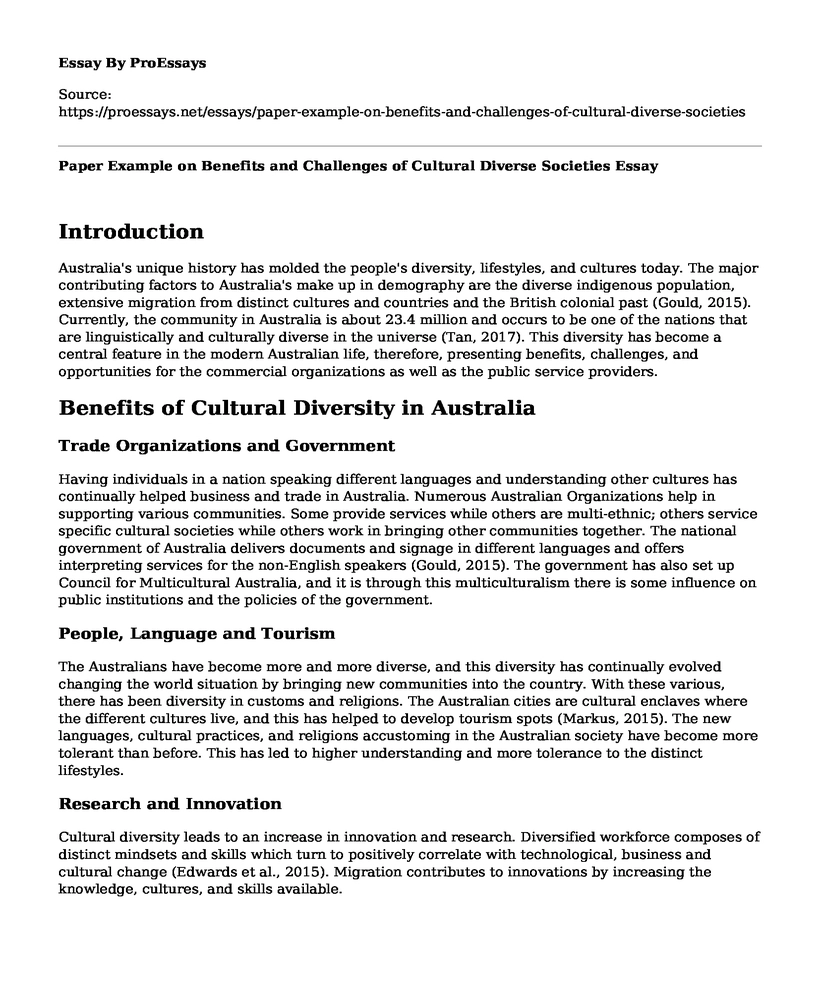Introduction
Australia's unique history has molded the people's diversity, lifestyles, and cultures today. The major contributing factors to Australia's make up in demography are the diverse indigenous population, extensive migration from distinct cultures and countries and the British colonial past (Gould, 2015). Currently, the community in Australia is about 23.4 million and occurs to be one of the nations that are linguistically and culturally diverse in the universe (Tan, 2017). This diversity has become a central feature in the modern Australian life, therefore, presenting benefits, challenges, and opportunities for the commercial organizations as well as the public service providers.
Benefits of Cultural Diversity in Australia
Trade Organizations and Government
Having individuals in a nation speaking different languages and understanding other cultures has continually helped business and trade in Australia. Numerous Australian Organizations help in supporting various communities. Some provide services while others are multi-ethnic; others service specific cultural societies while others work in bringing other communities together. The national government of Australia delivers documents and signage in different languages and offers interpreting services for the non-English speakers (Gould, 2015). The government has also set up Council for Multicultural Australia, and it is through this multiculturalism there is some influence on public institutions and the policies of the government.
People, Language and Tourism
The Australians have become more and more diverse, and this diversity has continually evolved changing the world situation by bringing new communities into the country. With these various, there has been diversity in customs and religions. The Australian cities are cultural enclaves where the different cultures live, and this has helped to develop tourism spots (Markus, 2015). The new languages, cultural practices, and religions accustoming in the Australian society have become more tolerant than before. This has led to higher understanding and more tolerance to the distinct lifestyles.
Research and Innovation
Cultural diversity leads to an increase in innovation and research. Diversified workforce composes of distinct mindsets and skills which turn to positively correlate with technological, business and cultural change (Edwards et al., 2015). Migration contributes to innovations by increasing the knowledge, cultures, and skills available.
Challenges of Cultural Diversity
Race Inequalities
Studies confirm that there are some races considered to be inferior or superior to others (Banks, 2015). Also, numerous students participating in a study conducted to ascertain that there are cases of discrimination because of religion ethnic religion or skin color. Individuals recently migrating into the country have encountered challenges while attempting to get employment.
Migration, Settlement and Social and Human Capital Losses
When individuals arrive in a new society, there is a lot of adjusting when settling. This process of adjustment is dynamic and involves psychological, social and political dimensions of the culture receiving them. Lack of English proficiency, lack of recognition of prior learning, lack of skills and qualifications, financial difficulties have an impact on the communities and the individuals on how well they participate in the society (Radermacher, & Feldman, 2017). The factors on the society such as the impacts on opportunities, social participation and belonging and identity are the essential prerequisites in community engagement and citizen participation for the well functioning of the Australian democracy.
Conclusion
In conclusion, ethnicity, religion or cultures are factors playing significant roles in privilege rendering for particular groups and excluding others. To build a socially democratic nation, it is essential to focus on issues of social inclusion, for instance, empowering communities, fostering the sense of belonging and building community capacity. Embracing of socially diverse communities offers social and economic advantages promoting a better society.
References
Banks, J. A. (2015). Cultural diversity and education: Foundations, curriculum, and teaching. Boston: Allyn and Bacon.
Edwards, M., Onyx, J., Maxwell, H., Darcy, S., Bullen, P., & Sherker, S. (2015). Joining the dots: Social Impact and Cultural Diversity. In Australia and New Zealand Third Sector Research Biennial Conference.
Gould, J. (2015, January 11). How arts organisations can reap the benefits of cultural diversity. Retrieved from https://theconversation.com/how-arts-organisations-can-reap-the-benefits-of-cultural-diversity-35914
Markus, A. (2015). Mapping social cohesion: The Scanlon Foundation Surveys 2015. Retrieved from Monash University website: http://scanlonfoundation.org.au/wp-content/uploads/2015/10/2015-Mapping-Social-Cohesion-Report.pdf
Radermacher, H., & Feldman, S. (2016). Cultural Diversity, Health and Ageing. International Perspectives on Aging, 83-101. doi:10.1007/978-1-4939-6466-6_6
Tan, S. (2017). Challenging citizenship: Group membership and cultural identity in a global age (1st ed.). London: Routledge.
Cite this page
Paper Example on Benefits and Challenges of Cultural Diverse Societies. (2022, May 22). Retrieved from https://proessays.net/essays/paper-example-on-benefits-and-challenges-of-cultural-diverse-societies
If you are the original author of this essay and no longer wish to have it published on the ProEssays website, please click below to request its removal:
- Emergency Management of "Deep Horizon" Event
- The Way to the West Book Review Paper Example
- What Can We Learn From Other Countries: Children and Families Paper Example
- Betel Quid Chewing in South-East Asia Paper Example
- Research Paper on Marriage, Kinship, and Family
- Savannah Wind Symphony's Concert Critique
- Essay Example on Law Enforcement: Challenges of Diversity in Answering 911 Calls







